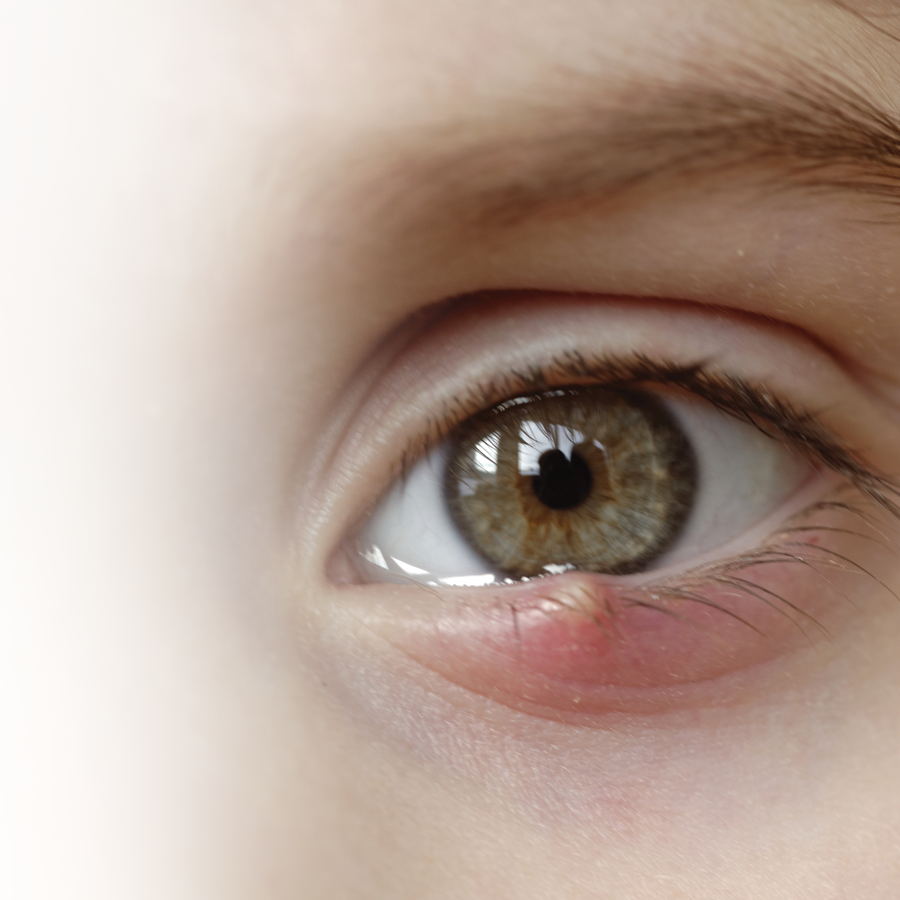What is that annoying little red lump that has suddenly appeared on your eyelid? It could be a stye.
What is a stye?
A stye (or external hordeolum) is a benign, temporary bacterial infection that appears as a small, reddish, painful bump on the edge of the upper or lower eyelid. Resembling a boil or acne pimple, this swelling is generally more unsightly than problematic, but can nevertheless be a source of pain and discomfort.
Stye or chalazion? Know the difference!
Although visually very similar, styes and chalazion are two distinct eye problems. Unlike styes, chalazions last longer and are never painful.
Types of styes
There are two types of styes that can form on the eyelid.
- External stye: this is the most common form of stye, developing at the base of the eyelash.
- Internal stye: much rarer and usually more painful, this type of stye develops inside the eyelid itself.
What causes a stye?
Styes usually develop as a result of infection of the sebaceous glands at the base of the eyelashes. Primarily caused by the bacterium staphylococcus aureus, this infection can develop as a result of several factors, including:
- Poor eye hygiene or the use of expired/contaminated makeup products;
- Blockage of the sebaceous glands around the eyelashes;
- Frequently rubbing the eyes (especially with dirty hands);
- Dusty, dirty or windy environments;
- Severe stress affecting the immune system.
Symptoms of a stye
Besides discomfort and pain, a stye can cause symptoms that include:
- Swelling of the eyelid;
- Tears;
- Hypersensitivity to light;
- Feeling as if there is a grain of sand in the eye;
- A sensation of eye inflammation.
How long does a stye last?
Styes generally last anywhere from a few days to a week or so.
How do I treat a stye?
Here is a simple and effective way to treat your stye and speed up healing.
- Take a clean cloth or sterile gauze pad and moisten it with warm (ideally boiled) water.
- Wait for the water to become lukewarm to avoid burning the delicate skin around the eye, then apply the cloth or compress to the stye for about 5 to 15 minutes while keeping the eye closed to promote tissue relaxation and help drain the stye naturally.
- Repeat this process three to four times a day for optimum results.
Above all, avoid touching, scratching or trying to pop the stye. In addition to being useless, such actions risk aggravating the infection and putting pressure on the eyeball, risking further damage to your eyes. You should also avoid wearing contact lenses or applying makeup to your eye until the stye has completely disappeared.
Several over-the-counter topical antibiotics in eye drop form are available at the pharmacy. Such products, however, are intended to treat conjunctivitis and generally not very effective for styes. In some cases, your doctor may prescribe a more specific treatment if your stye persists or develops complications.
When should I seek medical attention for this eye infection?
In the vast majority of cases, styes are harmless and of no consequence. However, they can sometimes become more serious or involve more complications. So, if the infection has not improved or has worsened within 48 hours of applying a warm compress, you should see a doctor or optometrist.
You should also see a doctor if:
- Your stye is getting bigger and bigger;
- You notice an increase in the production of pus in the eye;
- Your eyelid is very swollen or red;
- You have other ocular symptoms, including redness elsewhere than on the eyelid;
- The redness or swelling spreads to your cheek or other parts of your face;
- You have secretions, especially if they are coloured;
- The skin around the eye is peeling;
- Bleeding occurs;
- Your vision is impaired;
- You have a fever.
Your doctor may suggest antibiotics or anti-inflammatories, in the form of ointments or drops, to be applied to the eyelid or inside the eye. Your pharmacist can also advise you on directions for use, possible side effects, precautions to take and storage instructions for the drug in question.
In some exceptional cases, it may be necessary for a doctor to drain your stye.
How can I avoid getting a stye?
- Always wash your hands before touching your eyes or putting in contact lenses.
- Follow your eye doctor's instructions on hygiene and handling of your contact lenses.
- Always remove eye makeup properly before going to bed.
- Never share your makeup products with others, and never use anyone else's.
- Do not use eye medications or lubricating drops that have expired. These products should not be used more than one month after the bottle or tube has been opened.
Such preventive measures don't guarantee that you'll never get styes, but they do help reduce the risk.
Your eye health is precious!
Styes are generally minor, temporary conditions that can be treated at home and usually resolve within a week. However, if you suspect another condition, don't hesitate to talk to your pharmacist or health care professional. When it comes to your eye health, nothing beats a professional's advice!

